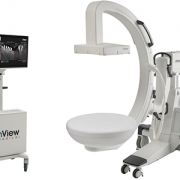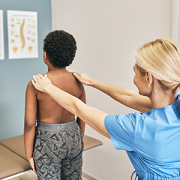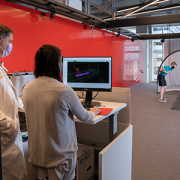Advancing care: Innovations and learning in Spinal Fusion Surgical Home

“We are committed to discovering methods that eliminate variability in the care process and enhance the quality of care for pediatric orthopaedic patients,” says Matthew Oetgen, M.D., M.B.A., chief of Orthopaedic Surgery and Sports Medicine at Children’s National Hospital.
“We are committed to discovering methods that eliminate variability in the care process and enhance the quality of care for pediatric orthopaedic patients,” says Matthew Oetgen, M.D., M.B.A., chief of Orthopaedic Surgery and Sports Medicine at Children’s National Hospital. “The Spinal Fusion Surgical Home model is specifically designed for young patients with adolescent idiopathic scoliosis (AIS), laying the foundation for numerous other children undergoing various surgical procedures.”
The first-of-its-kind for pediatric patients, the Children’s National Spinal Fusion Surgical Home continues to streamline care with an emphasis on increasing quality outcomes for patients. At its inception, the program implemented a newly developed model of care to optimize the spinal fusion process for AIS patients. As a leader in this care concept, Children’s National has standardized the infection-control process, pain-management pathway and physical-therapy program for patients undergoing spinal fusion.
The patient benefit
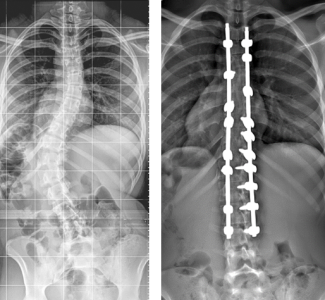
A patient with a right thoracic deformity of approximately 33 degrees and a left thoracolumbar deformity of 54 degrees was treated with an instrumented posterior spinal fusion from T4-L3 and was admitted for 5 days post-operatively.
Children’s National has implemented standardized protocols and ongoing enhancements, including the establishment of a specialized surgical team and the integration of a Lean process analysis. This has led to a notable decrease in the average length of stay for spinal fusion patients from about five days to three days. The surgical home has also reduced the transfusion rate from 30% to 12% and patient pain scores have decreased. Additionally, the number of patients who have returned to the emergency department due to complications has also decreased.
In a case prior to the surgical home model being established, a patient with a right thoracic deformity of approximately 33 degrees and a left thoracolumbar deformity of 54 degrees was treated with an instrumented posterior spinal fusion from T4-L3 and was admitted for 5 days post-operatively. Per standard protocol at the time, this patient stayed in the intensive care unit (ICU) immediately after surgery for a day and a half.
In another case, a patient with a right thoracic deformity of 58 degrees and left thoracolumbar deformity of 67 degrees was treated with a similar instrumented posterior spinal fusion from T4-L3 and admitted for 2.5 days post-operatively. With the new model in place, this patient did not need any time in the ICU, required less length of stay and had less loss of blood.
“By working together with all our care givers, we have been able to standardize our care and decrease care variability. This has proven effective at improving outcomes allowing our patients to recover faster and avoid complications. These cases are an example of our system being primed to treat children with ever increasing complexity with better and better outcomes,” says Dr. Oetgen.
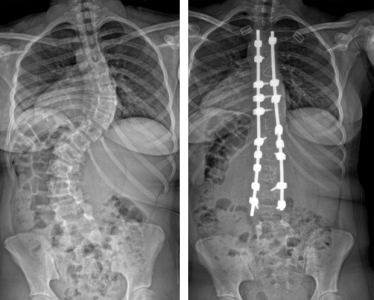
A patient with a right thoracic deformity of 58 degrees and left thoracolumbar deformity of 67 degrees was treated with a similar instrumented posterior spinal fusion from T4-L3 and admitted for 2.5 days post-operatively.
Children’s National leads the way
Over the years, the Spinal Fusion Surgical Home has continuously fine-tuned its approach, resulting in greater success outcomes and better patient care. Children’s National orthopaedic experts have published many articles highlighting this evolution:
- Lean process mapping: Implementation of a standardized care pathway developed with the use of the Lean process mapping technique to create an evidence-based protocol for preoperative, operative, postoperative and post-discharge care. Since 2015 our program has demonstrated effective and sustained improvements to the care of patients and decreased postoperative length of stay.
- Significant decrease in perioperative blood transfusions: A study published in Pediatric Anesthesia details team findings that implementation of blood-conservation strategies as part of a perioperative surgical home for patients with AIS undergoing posterior spine fusion resulted in significant decrease in perioperative blood transfusions.
- Reduced patient length of stay: An in-depth Lean process mapping technique improved outcomes and decreased length of stay of patients, as outlined in an article in Spine Deformity, through use of a standardized care pathway. Work to improve surgical efficiency, intraoperative fluid and blood management, and postoperative pain management continues to further improve effectiveness.
- Standardization of intraoperative pain control: A study published in the Journal of Anesthesia on the implementation of the medical home model for AIS-improved pain control and decreased opioid consumption and hospital stay. Through pathway standardization, consistent multi-modal analgesia and early mobilization, the medical home model improved outcomes and is our standard of care.
- Reduction in perioperative outcome disparities: Acknowledging the well-documented racial and ethnic disparities in treatment and perioperative outcomes for patients across healthcare, the team documented and published findings that this model was able to reduce racial and ethnic disparities in length of stay and pain scores.
- Dedicated surgical team: Having dedicated spine personnel in the operating room decreases surgical time and improves clinical outcomes, as detailed in a study on Spine Deformity.
Read more about our advances in Orthopaedic Surgery and Sports Medicine.



